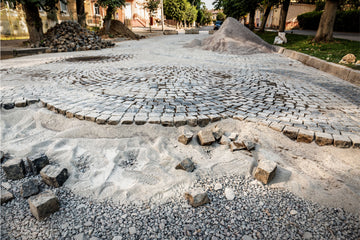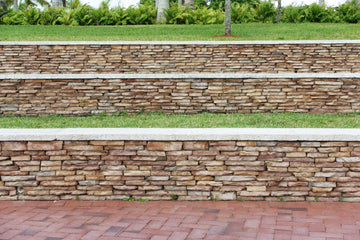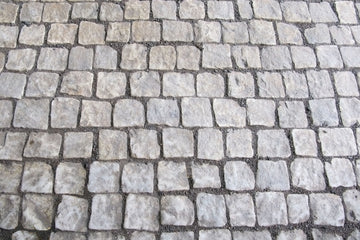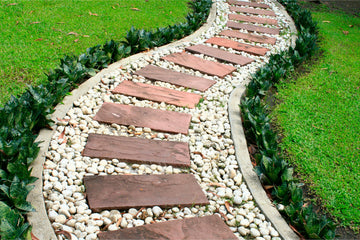How to Calculate Stone Quantity for Large Landscape Projects

Accurate natural stone quantity calculation represents a critical competency for landscape contractors, garden designers, and stone suppliers managing large-scale projects. Underestimating material requirements causes costly project delays and additional freight expenses, while overordering ties up capital and creates waste disposal challenges. This comprehensive guide provides professional methodologies for calculating sandstone paving, limestone slabs, granite pavers, wall stone, and other natural stone materials for commercial and residential landscape installations.
Foundation Principles of Stone Quantity Calculation
Understanding Coverage Rates and Wastage Factors
Natural stone coverage rates depend on slab dimensions, joint spacing, and installation pattern. Standard rectangular paving in consistent sizes provides predictable coverage, while random pattern installations using mixed dimensions require adjusted calculations. Landscape contractors must account for cutting waste, breakage during handling, and pieces rejected due to excessive variation or damage.
Industry standard wastage allowances range from 5-10% for straightforward rectangular installations with minimal cutting, increasing to 15-20% for complex patterns, curved edges, or projects requiring extensive trimming. Stone suppliers should educate buyers on appropriate wastage factors to prevent material shortfalls that compromise project schedules.
Calibrated natural stone with consistent thickness and dimensions minimizes wastage compared to hand-cut stone requiring additional trimming for proper fit. Landscape projects specifying premium materials should factor reduced wastage rates, while budget-conscious developments using economy-grade stone may experience higher rejection rates requiring additional allowances.
Calculating Natural Stone Paving Quantities
Square Meter Coverage Method
The fundamental approach to natural stone paving calculation starts with total project area measurement in square meters. Landscape designers should provide detailed site plans showing paving areas, distinguishing between different stone types, colors, or sizes within the project scope. Accurate area measurement forms the foundation for all subsequent quantity calculations.
For rectangular paving areas, multiply length by width to determine square meters. Irregular shapes require subdivision into manageable geometric sections—rectangles, triangles, and circles—calculated separately then summed for total area. Digital measurement tools and CAD software streamline area calculation for complex landscape designs, reducing human error in manual measurements.
After establishing total paving area, apply appropriate wastage factors based on project complexity. A simple rectangular patio with minimal border details requires 5% wastage (multiply area by 1.05), while elaborate patterns with extensive cutting demand 15% or higher (multiply by 1.15 or greater). Stone suppliers offering quantity calculation support help contractors avoid costly estimation errors.
Paving Slab Count Calculations
Alternative calculation methodology involves determining the number of individual paving slabs required based on standard stone dimensions. Common sandstone paving sizes include 600x600mm, 600x900mm, 900x600mm, and 300x600mm calibrated slabs. Calculate the coverage area per slab by converting dimensions to meters and multiplying length by width.
For example, a 600x600mm slab covers 0.36 square meters (0.6m x 0.6m = 0.36m²). Divide total project area by coverage per slab to determine the quantity needed. A 50 square meter patio requires 139 pieces of 600x600mm paving (50 ÷ 0.36 = 138.9, rounded up). Add wastage percentage to arrive at order quantity: 139 x 1.10 = 153 slabs for 10% wastage allowance.
Mixed size paving projects require proportional calculations based on specified size ratios. A project using 70% large format and 30% small format stone demands separate calculations for each size category, ensuring the correct mix arrives on site. Stone suppliers should confirm size distribution with contractors before processing mixed-size orders.
Joint Spacing Considerations
Joint width affects overall coverage rates, particularly for projects specifying wide joints for design effect or permeable paving requirements. Standard joint spacing of 3-5mm has minimal impact on quantity calculations, but wide joints of 10-20mm reduce effective coverage per slab. Calculate adjusted coverage by subtracting joint width from slab dimensions before computing area.
For a 600x600mm slab with 10mm joints, effective coverage dimensions become 590x590mm (348,100mm² or 0.348m²) rather than 360,000mm² (0.36m²). This 3.3% reduction in coverage per slab increases total quantity requirements proportionally. Landscape contractors specifying wide joints must adjust calculations accordingly to prevent material shortages.
Natural Stone Wall Quantity Calculations
Retaining Wall Stone Estimation
Natural stone retaining walls require volume-based calculations accounting for wall dimensions and stone density. Measure wall length, average height, and thickness to determine total volume in cubic meters. A 10-meter long wall, 1.2 meters high, and 0.4 meters thick contains 4.8 cubic meters (10m x 1.2m x 0.4m = 4.8m³).
Stone density varies by type: sandstone averages 2,200-2,400 kg/m³, limestone ranges 2,300-2,600 kg/m³, and granite reaches 2,600-2,700 kg/m³. Convert volume to weight by multiplying cubic meters by material density. The example wall in sandstone at 2,300 kg/m³ requires 11,040 kilograms or approximately 11 metric tons (4.8m³ x 2,300 kg/m³ = 11,040 kg).
Dry-stack walls using irregular quarried stone typically require 10-15% additional material compared to mortared walls with consistent courses. Account for voids between irregular pieces and selective stone placement that leaves unusable pieces. Stone suppliers should quote wall stone by weight (metric tons) rather than volume to ensure accurate pricing and delivery quantities.
Veneer and Cladding Stone Calculations
Natural stone veneer for feature walls follows similar methodology to paving calculations, measuring wall surface area and applying appropriate wastage factors. Thin veneer stone typically comes in random sizes requiring pattern-fitting during installation, necessitating higher wastage allowances of 15-20% compared to rectangular paving.
Corner pieces, trim stones, and specialty shapes require separate quantity calculations based on linear meters of corners, wall caps, or base courses. Landscape contractors should provide detailed elevation drawings showing all trim elements to ensure complete material orders. Incomplete orders missing specialty pieces delay project completion more severely than insufficient field stone.
Natural Stone Step Calculations
Calculating Step Treads and Risers
Stone step calculations require counting the number of risers (vertical faces) and treads (horizontal walking surfaces) within each stairway section. Measure total elevation change and divide by desired step height (typically 150-180mm) to determine riser count. Tread count equals riser count for stairs terminating at grade, or riser count minus one for stairs between two level surfaces.
Standard stone step treads measure 1200-1500mm wide and 350-400mm deep. Calculate linear meters of treads by multiplying tread count by width. A stairway with 8 treads at 1400mm width requires 11.2 linear meters of tread stone (8 x 1.4m = 11.2m). Stone suppliers typically sell step treads by linear meter, with pricing varying by stone type, thickness, and finish specifications.
Riser calculations follow the same linear meter methodology. Eight risers at 1400mm width require 11.2 linear meters of riser stone. Landscape contractors may specify separate stone types for treads and risers, requiring distinct quantity calculations for each element. Include modest wastage allowance (5-10%) for steps to accommodate breakage during fabrication or installation.
Curved and Custom Steps
Curved stone steps require radius measurements and arc length calculations to determine accurate quantities. For constant-radius curves, calculate arc length using the formula: arc length = radius × angle (in radians). Alternatively, use specialized measurement tools or CAD software to determine curved step dimensions accurately. Stone fabrication for curved steps includes additional material costs and lead times that contractors must communicate to clients.
Bulk Order Considerations for Large Projects
Phased Delivery Calculations
Large landscape developments spanning multiple construction phases require careful material quantity allocation across delivery schedules. Calculate stone requirements for each project phase independently, confirming that cumulative quantities match overall project needs. Coordinate delivery timing with construction schedules to minimize on-site storage requirements while preventing work stoppages due to material depletion.
Stone suppliers should maintain consistent product availability throughout multi-phase projects. Batch variation in natural stone means that material from different production runs may show color differences. Specify single batch orders when possible, or plan transitions between batches at logical project divisions where slight variation becomes less noticeable.
Container Load Optimization
International stone imports require container load optimization to minimize freight costs per unit. Standard 20-foot containers hold approximately 25-28 metric tons depending on stone density and packaging, while 40-foot containers accommodate 50-56 metric tons. Calculate project quantities to maximize container utilization without exceeding weight limits.
Mixed orders combining paving, wall stone, and steps within single containers require careful planning to achieve efficient loading. Stone suppliers with containerization expertise help landscape contractors optimize orders, potentially reducing per-unit costs by 15-25% compared to partially filled containers.
Digital Tools and Calculation Resources
Software Solutions for Quantity Takeoff
Professional landscape contractors increasingly utilize digital quantity takeoff software that calculates material requirements from imported site plans. These tools reduce calculation errors, streamline estimation processes, and generate detailed material lists for supplier quotations. Stone suppliers offering compatible digital ordering systems improve procurement efficiency for tech-enabled contractors.
Supplier Calculation Support Services
Leading natural stone exporters provide technical calculation support, reviewing project plans and generating accurate material quantities. This value-added service reduces contractor risk, improves order accuracy, and builds long-term supply partnerships. Stone suppliers should train staff in quantity calculation methodologies to deliver professional estimation support.
Quality Control and Order Verification
Before finalizing stone orders, landscape contractors should verify calculations through independent review by experienced estimators. Double-check area measurements, confirm wastage allowances, and validate stone specifications against design documents. Cross-reference supplier quotations against independent calculations to identify discrepancies before purchase commitments.
Maintain detailed calculation documentation including area measurements, wastage factors, and specification notes. This record-keeping facilitates order adjustments during construction, supports change order pricing, and provides reference data for future similar projects.
Conclusion
Accurate natural stone quantity calculation combines technical measurement skills, material knowledge, and practical construction experience. Landscape contractors mastering these calculation methodologies reduce project risks, optimize material costs, and deliver successful installations. Stone suppliers supporting contractors with calculation assistance, product availability, and technical expertise become valued partners in landscape project success. Proper quantity estimation transforms natural stone procurement from risky guesswork into reliable, professional practice that benefits all project stakeholders.






